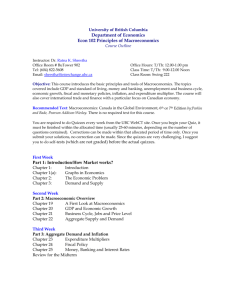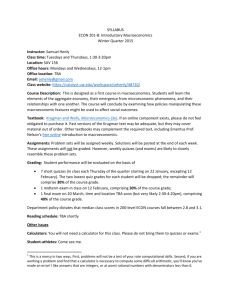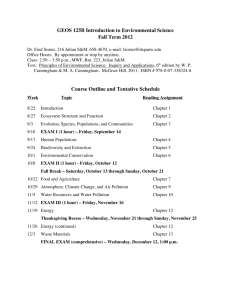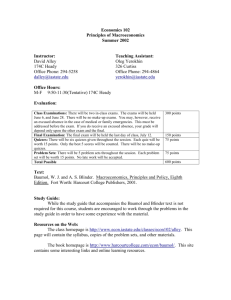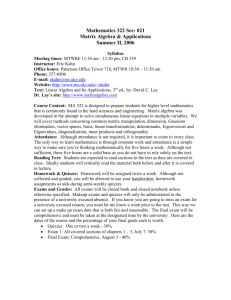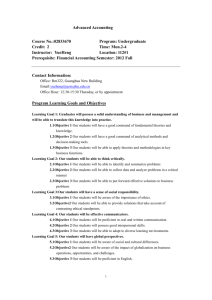economics 104 roth
advertisement
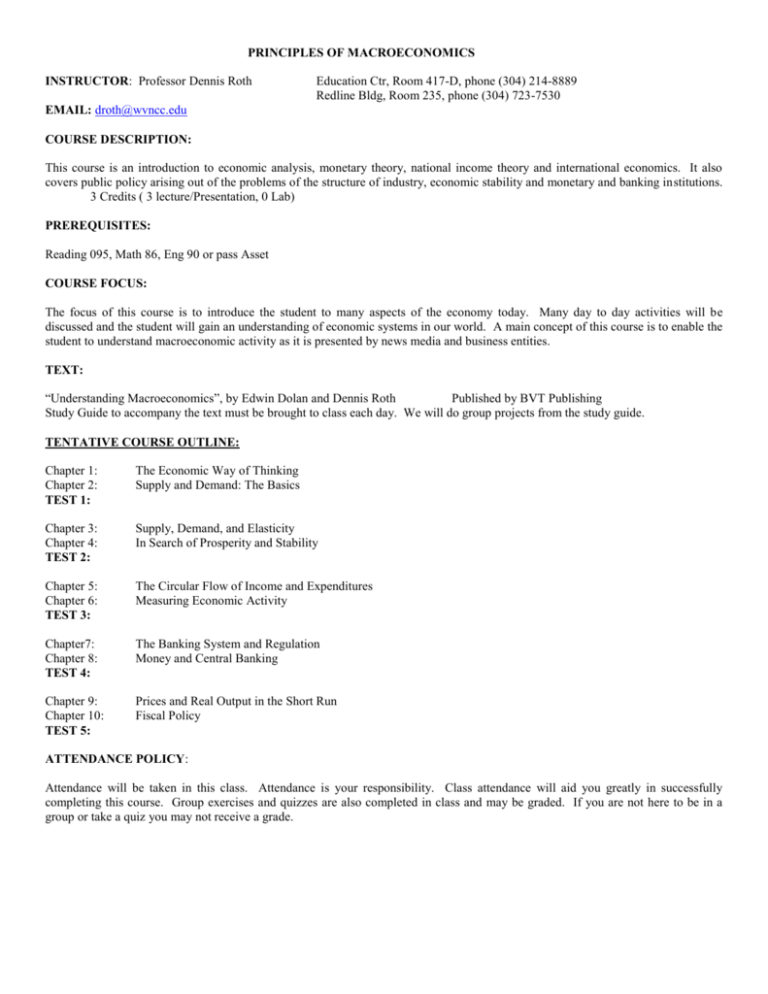
PRINCIPLES OF MACROECONOMICS INSTRUCTOR: Professor Dennis Roth Education Ctr, Room 417-D, phone (304) 214-8889 Redline Bldg, Room 235, phone (304) 723-7530 EMAIL: droth@wvncc.edu COURSE DESCRIPTION: This course is an introduction to economic analysis, monetary theory, national income theory and international economics. It also covers public policy arising out of the problems of the structure of industry, economic stability and monetary and banking institutions. 3 Credits ( 3 lecture/Presentation, 0 Lab) PREREQUISITES: Reading 095, Math 86, Eng 90 or pass Asset COURSE FOCUS: The focus of this course is to introduce the student to many aspects of the economy today. Many day to day activities will be discussed and the student will gain an understanding of economic systems in our world. A main concept of this course is to enable the student to understand macroeconomic activity as it is presented by news media and business entities. TEXT: “Understanding Macroeconomics”, by Edwin Dolan and Dennis Roth Published by BVT Publishing Study Guide to accompany the text must be brought to class each day. We will do group projects from the study guide. TENTATIVE COURSE OUTLINE: Chapter 1: Chapter 2: TEST 1: The Economic Way of Thinking Supply and Demand: The Basics Chapter 3: Chapter 4: TEST 2: Supply, Demand, and Elasticity In Search of Prosperity and Stability Chapter 5: Chapter 6: TEST 3: The Circular Flow of Income and Expenditures Measuring Economic Activity Chapter7: Chapter 8: TEST 4: The Banking System and Regulation Money and Central Banking Chapter 9: Chapter 10: TEST 5: Prices and Real Output in the Short Run Fiscal Policy ATTENDANCE POLICY: Attendance will be taken in this class. Attendance is your responsibility. Class attendance will aid you greatly in successfully completing this course. Group exercises and quizzes are also completed in class and may be graded. If you are not here to be in a group or take a quiz you may not receive a grade. GRADING POLICY: Grades will be determined from an average of the following: 5 Test Scores = 100 points each Class projects and quizzes = 100 points GRADING SCALE: A = 540 to 600 points B = 480 to 539 points C – 420 to 479 points D = 360 to 419 points F = 000 to 359 points IMPORTANT: Makeup exams are not given without prior notification of the professor, as of the date the test is to be issued. If a makeup test is permitted, each class date that passes without making up the test will result in the outcome of the test score being lowered by one full letter grade. If a makeup test is given, the instructor reserves the right to administer a different, yet similar, test than the class took. IF BONUS QUIZZES ARE GIVEN, NO MAKUP QUIZZES ARE GIVEN. Cheating will result in a failing grade and withdrawal from the course. HOMEWORK: The only homework that is projected is to read the chapters prior to coming to class. COURSE GOALS: The main goal of this course is to introduce the student to macroeconomics. The students should be able to understand what is happening in the economic world around them. They should be able to read the paper or watch the news and understand what is being said. COURSE OBJECTIVES: 1) 2) 3) 4) 5) 6) 7) 8) 9) 10) 11) 12) 13) 14) 15) 16) 17) 18) 19) 20) 21) 22) 23) 24) 25) 26) 27) 28) 29) 30) 31) grasp what economics is define opportunity cost interpret the production possibility frontier (curve) define scarcity define entrepreneurship understand choices and trade offs differentiate capitalism, socialism and communism grasp supply and demand define markets analyze the price system define equilibrium differentiate shortage and surplus understand elasticity apply concepts of elasticity analyze the business cycle calculate unemployment rate assess unemployment understand circular flow illustrate the planned expenditure model illustrate the planned saving model calculate marginal propensity to consume and save calculate average propensity to consume and save apply the multiplier define gross domestic product assess GDP for price changes calculate GDP compute price indexes and GDP define money define the money supply examine how banks operate complete a banks balance sheet 32) 33) 34) 35) 36) 37) 38) 39) 40) 41) 42) 43) 44) 45) define monetary policy define the functions of the federal reserve system explain how banks create money calculate the velocity of money understand aggregate supply and demand understand fiscal policy define budget surplus and deficit explain the national debt explain wage and price controls understand the Phillips curve analyze inflation and the quantity of money understand income policy explain productivity calculate change in productivity Revised Aug 10, 2011
